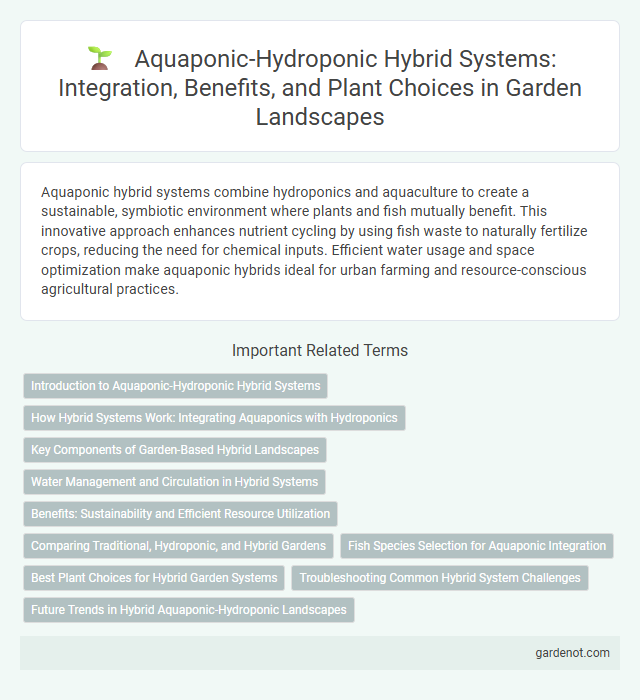Aquaponic hybrid systems combine hydroponics and aquaculture to create a sustainable, symbiotic environment where plants and fish mutually benefit. This innovative approach enhances nutrient cycling by using fish waste to naturally fertilize crops, reducing the need for chemical inputs. Efficient water usage and space optimization make aquaponic hybrids ideal for urban farming and resource-conscious agricultural practices.
Introduction to Aquaponic-Hydroponic Hybrid Systems
Aquaponic-hydroponic hybrid systems integrate aquaculture with soil-free plant cultivation, creating a symbiotic environment where fish and plants mutually benefit from nutrient exchange. These systems use fish waste as a natural fertilizer for hydroponically grown plants, enhancing sustainability by reducing the need for synthetic nutrients. The hybrid model maximizes resource efficiency and promotes higher yields in controlled-environment agriculture.
How Hybrid Systems Work: Integrating Aquaponics with Hydroponics
Hybrid systems combine aquaponics and hydroponics by using fish waste as a natural nutrient source for plants grown in a soilless medium, enhancing nutrient availability and water efficiency. Water from the fish tank, rich in ammonia, is converted by beneficial bacteria into nitrates, which are then absorbed by hydroponic plants, promoting rapid growth and reducing chemical fertilizer use. This integrated approach creates a sustainable cycle where plants filter and purify the water before it returns to the fish tank, maintaining optimal environmental conditions for both aquatic and plant life.
Key Components of Garden-Based Hybrid Landscapes
Aquaponic hybrid garden-based landscapes combine aquaculture and hydroponics to create a sustainable ecosystem where fish waste provides nutrients for plants. Key components include a fish tank, biofilter, grow beds filled with media such as expanded clay or gravel, and a water circulation system that maintains nutrient-rich water flow between fish and plants. Integrated monitoring systems optimize pH, temperature, and nutrient levels, ensuring balanced growth and maximum productivity in the hybrid landscape.
Water Management and Circulation in Hybrid Systems
Aquaponic hybrid systems integrate hydroponic plant cultivation with aquaculture, requiring precise water management to maintain optimal nutrient balance and oxygen levels. Efficient circulation systems recycle water between fish tanks and grow beds, minimizing waste and enhancing filtration through biofiltration processes that convert fish waste into plant nutrients. Maintaining stable pH, temperature, and dissolved oxygen is critical to promoting healthy fish and robust plant growth in these symbiotic environments.
Benefits: Sustainability and Efficient Resource Utilization
Aquaponic hybrid systems combine aquaculture and hydroponics, optimizing water use by recycling nutrient-rich fish waste to nourish plants, significantly reducing water consumption compared to traditional agriculture. This sustainable approach enhances resource efficiency through closed-loop nutrient cycling, minimizing waste and energy input while maximizing crop yield and fish production. By integrating these systems, aquaponics supports sustainable food production with reduced environmental impact and improved ecosystem balance.
Comparing Traditional, Hydroponic, and Hybrid Gardens
Traditional gardens rely on soil and natural nutrient cycles, which can limit growth speed and water efficiency. Hydroponic gardens use nutrient-rich water solutions to accelerate plant growth and reduce water usage by up to 90% compared to conventional methods. Aquaponic hybrids combine hydroponics with aquaculture, creating a sustainable ecosystem where fish waste provides nutrients for plants, enhancing resource efficiency and minimizing environmental impact.
Fish Species Selection for Aquaponic Integration
Choosing the right fish species for aquaponic integration in hydroponic landscapes is crucial for system balance and productivity. Tilapia, catfish, and trout are popular choices due to their adaptability to varying water conditions and rapid growth rates. Selecting species that thrive in the specific water temperature and pH range of the aquaponic system enhances nutrient cycling and supports healthy plant growth.
Best Plant Choices for Hybrid Garden Systems
Lettuce, kale, and basil thrive in aquaponic hybrid garden systems due to their rapid growth and nutrient absorption efficiency. Tilapia or catfish provide essential nutrients through their waste, creating a sustainable symbiotic environment for these plants. Selecting fast-growing leafy greens alongside nutrient-demanding herbs maximizes yield and system balance in aquaponic setups.
Troubleshooting Common Hybrid System Challenges
Aquaponic hybrid systems require careful balancing of fish health and plant growth to avoid nutrient deficiencies and toxic buildups. Common challenges include clogging in water delivery lines and inconsistent pH levels that disrupt microbial activity essential for nutrient cycling. Regular monitoring of water parameters and maintaining appropriate filtration systems are critical for sustaining optimal system performance.
Future Trends in Hybrid Aquaponic-Hydroponic Landscapes
Emerging trends in hybrid aquaponic-hydroponic landscapes emphasize sustainable urban farming, integrating fish cultivation with soil-less plant growth to maximize resource efficiency. Advanced automation and AI-driven nutrient management systems optimize water usage and crop yields, supporting scalable, eco-friendly food production. Innovations in renewable energy integration further enhance the sustainability and resilience of these hybrid agricultural systems.
Aquaponic hybrid Infographic

 gardenot.com
gardenot.com